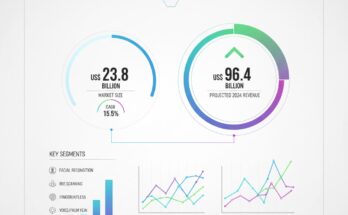In today’s fast-moving digital economy, the pressure is on: organizations must deliver software rapidly, keep costs down, and adapt continuously. Traditional development paths—drawing from large engineering teams, lengthy specifications, and long release cycles—are increasingly unable to keep up. Enter the Low Code Development Market, a paradigm shift that’s democratizing application development and enabling companies to respond swiftly to business demands.
Low Code Development Market Size, Forecast & Growth Trajectory
The Low Code Development Market is reaching scale. As of 2024, its estimated global value is approximately USD 22.5 billion. Projections indicate a compound annual growth rate (CAGR) of around 26.8% from 2024 through 2034, with the market expected to expand to about USD 241.9 billion by 2034. These figures reflect the accelerating push toward automation, cloud-native delivery, and the increasing influence of citizen developers and business users in creating applications. (Based on Fact.MR estimates.)
Such ambitious growth signals more than just rising demand—it points to a broader transformation in how enterprises build software, with low-code becoming a foundational capability rather than a nice-to-have.
Key Drivers Fueling Adoption
Several interlocked forces are driving the surge in low code platform uptake:
-
Digital transformation urgency: Across industries, there is a pressing need to modernize legacy systems, improve time to market, and scale digital experiences—whether in customer-facing apps, internal workflows, or data dashboards. Low code platforms deliver powerful tools to address these needs with less dependence on specialized software engineers.
-
Shortage of coding talent: The global shortage of skilled developers has been a consistent obstacle to scaling digital efforts. Low code platforms provide abstractions, pre-built components, and visual development tools that allow less technical users to build or support applications, thereby stretching development capacity.
-
Cost & time efficiency: By reducing manual code writing, lowering debugging burdens, simplifying deployment, and enabling reuse of components, low code platforms reduce both cost and risk. Businesses now expect faster delivery without compromising governance, security, or scalability.
-
Generative AI and intelligent automation: AI support features—such as auto-suggested logic, templates, or predictive models—are increasingly embedded into low code platforms, further accelerating development and reducing error rates. The integration of AI is looked at as a game changer in enhancing value propositions of these platforms.
Regional Insights: United States & Europe
United States
The U.S. is a dominant market in the Low Code Development domain. In 2024, U.S. demand contributed approximately USD 2.5 billion to the global market. The growth rate in the U.S. mirrors the global trend, with a projected CAGR near 26-27% through 2034, setting U.S. market size to rise to nearly USD 26.7 billion by that year. Major drivers in the U.S. include enterprise adoption of cloud platforms, regulatory pressure to modernize, and high uptake of innovation in AI and automation. Additionally, many low code vendors are U.S.-based or have strong operations there, giving them proximity to major clients, investment, and technological innovation.
Europe
Europe is also progressing rapidly. While not always growing as aggressively as some Asia-Pacific markets, Europe benefits from mature developer ecosystems, strong regulatory frameworks, and high demand for enterprise apps. Countries like the UK, Germany, France, Netherlands, and the Nordics are among the early adopters. European enterprises are using low code to satisfy digital transformation mandates, improve operational efficiency, and support remote work and distributed teams. Also, data protection laws and GDPR compliance requirements influence how platforms are designed, deployed, and governed, giving Europe a distinctive role in shaping low code platform standards.
Segmentation Highlights & Market Share Trends
-
Deployment mode: Cloud-based low code development platforms are dominating in revenue and adoption. Businesses are drawn to the flexibility, scalability, and lower upfront infrastructure costs that cloud deployments offer, coupled with faster update cycles and managed environments.
-
Verticals & use cases: Banking, financial services & insurance (BFSI) is one of the most active verticals, leveraging low code platforms for customer onboarding, compliance, workflow automation, and chatbots. Other fast-adopters include retail & e-commerce (for custom apps and dashboards), healthcare (for patient data systems, scheduling apps), and government (for citizen services platforms and internal systems).
-
Enterprise size: SMEs (small & medium enterprises) are gaining ground with low code, as the reduction in development time and cost makes custom software more accessible. Large enterprises also invest heavily, particularly in platforms that provide robust governance, security, integration with legacy systems, and scale.
Browse Full Report: https://www.factmr.com/report/low-code-development-market
Challenges and Headwinds
While the momentum is strong, several challenges remain that could temper growth or affect platform selection:
-
Customization vs. flexibility tradeoffs: Low code platforms, by their nature, simplify many aspects of development—but with that simplicity comes constraints. Highly specialized or unique UI/UX, intricate performance tuning, deep integrations, or novel architectures sometimes require traditional development or hybrid approaches.
-
Vendor lock-in & interoperability: When organizations build heavily on a given low code platform, moving off it (or integrating with other platforms or legacy systems) can be difficult. Interoperability, standard APIs, and flexible export/import capabilities are essential to mitigate risk.
-
Security, governance, and compliance: As more business users design apps, ensuring secure code, appropriate access controls, audit logging, and regulatory compliance (privacy, data handling) is critical. Low code platforms must embed these features, not treat them as add-ons.
-
Talent & skill gaps: Ironically, while low code reduces dependence on developer skills, understanding how to architect applications, scale them, maintain them, and avoid technical debt still requires skilled engineers. Organizations need to balance democratization with technical oversight.
Outlook & Strategic Implications
Looking toward 2034, the Low Code Development Market is not merely about automating app creation—it’s about enabling organizations to act faster, be more resilient, and adapt continuously. The platforms that will win are those that can deliver: strong governance; integrations with AI, ML, data analytics; seamless cloud or hybrid deployment; and robust support/maintenance.
For vendors, strategic priorities include expanding feature sets (AI-assisted development, low code + no code blends), ensuring compliance (security, privacy regulations), building regional presence (especially in regions like Asia-Pacific, Latin America, and Eastern Europe), and offering services (customization, onboarding, support) alongside platform licenses.
For end users—enterprises, governments, SMEs—the value proposition is clear: faster innovation cycles, lower cost of custom software, greater agility, and more alignment between business needs and software delivery. But to fully leverage these gains, organizations need to rethink governance, architecture, and culture of software production.


